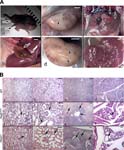Phenotypes associated with this allele
|
|
| Find Mice |
Using the International Mouse Strain Resource (IMSR)
Mouse lines carrying:
Pkhd1tm1Gwu mutation
(0 available);
any
Pkhd1 mutation
(222 available)
|
|
|
renal/urinary system
|
|
• kidneys exhibit increased apoptosis as indicated with increased caspase-3 and TUNEL staining; considerable apoptotic debris is seen in the lumen of renal tubules
|
|
|
• 6-week and 6-month old mice exhibit less cell proliferation in the kidneys than controls as indicated by fewer positive Phospho-Histone H3 staining spots and reduced PCNA staining
|
cellular
|
|
• kidneys exhibit increased apoptosis as indicated with increased caspase-3 and TUNEL staining; considerable apoptotic debris is seen in the lumen of renal tubules
|
|
|
• 6-week and 6-month old mice exhibit less cell proliferation in the kidneys than controls as indicated by fewer positive Phospho-Histone H3 staining spots and reduced PCNA staining
|
|
|
| Find Mice |
Using the International Mouse Strain Resource (IMSR)
Mouse lines carrying:
Pkhd1tm1Gwu mutation
(0 available);
any
Pkhd1 mutation
(222 available)
|
|
|

Cystic kidneys and other phenotypes in Pkd2tm1Gwu/Pkd2tm1Gwu and Pkhd1tm1Gwu/Pkhd1tm1Gwu mice
mortality/aging
|
|
• by 12 months of age, mice exhibit more adult mortality than wild-type mice
|
|
|
• fewer than expected mice are born
|
renal/urinary system
|
|
• at 2 months of age, mice exhibit a reduction of glomerular capillary loop formation compared to in wild-type mice
|
|
|
• in vivo and in culture, renal tubular epithelia have fewer and shorter cilia than on wild-type cells
|
|
|
• at 2 months of age, mice exhibit increased mesangial cellularity
|
|
|
• mice exhibit kidney cysts accompanied by fibrosis and necrosis
• severity of cysts and age of onset varies
|
|
|
• mice display focal dilation of papillary collecting ducts unlike in wild-type mice
|
|
|
• at 2 months of age, mice exhibit expansion of Bowman's space
|
|
|
• mice exhibit massive, fusiform, dilated renal tubules unlike in wild-type mice
(J:143124)
• at 1 month, mice exhibit mild to severe tubular dilation with flattening of tubular epithelial cells unlike in wild-type mice
(J:143394)
• at 2 months, the severity of tubular dilation is increased
(J:143394)
• at 4 months, tubular dilation encompassed 80% of the cortical medulla
(J:143394)
|
|
|
• mice exhibit patchy dilation of the proximal tubule
|
liver/biliary system
|
|
• mice exhibit dilated renal hepatic central veins with a patchy, periportal, lymphocytic infiltrate unlike in wild-type mice
|
|
|
• mice exhibit areas of hemorrhage and necrosis
|
|
|
• mice exhibit liver cysts accompanied by fibrosis and necrosis with varying severity and age of onset
|
endocrine/exocrine glands
|
|
• mice exhibit dilated pancreatic ducts unlike in wild-type mice
(J:143124)
|
nervous system
|
|
• mice exhibit brain cysts or dilated ducts
|
digestive/alimentary system
|
|
• mice exhibit dilated pancreatic ducts unlike in wild-type mice
(J:143124)
|
|
|
• mice exhibit hemorrhaging and ulcer-like lesions in the gastrointestinal tract
|
cardiovascular system
|
|
• at 2 months of age, mice exhibit a reduction of glomerular capillary loop formation compared to in wild-type mice
|
cellular
|
|
• in vivo and in culture, renal tubular epithelia have fewer and shorter cilia than on wild-type cells
|
|
|
• at 2 months of age, mice exhibit increased mesangial cellularity
|
|
|
• mice exhibit areas of hemorrhage and necrosis
|
growth/size/body
|
|
• mice exhibit kidney cysts accompanied by fibrosis and necrosis
• severity of cysts and age of onset varies
|
|
|
• mice exhibit liver cysts accompanied by fibrosis and necrosis with varying severity and age of onset
|
|
|
| Find Mice |
Using the International Mouse Strain Resource (IMSR)
Mouse lines carrying:
Pkd2tm2Som mutation
(0 available);
any
Pkd2 mutation
(84 available)
Pkhd1tm1Gwu mutation
(0 available);
any
Pkhd1 mutation
(222 available)
|
|
|
renal/urinary system
|
|
• at 1 month of age, mice have more sphere-shaped cysts than in Pkdh1tm1Gwu homozygotes
|
growth/size/body
|
|
• at 1 month of age, mice have more sphere-shaped cysts than in Pkdh1tm1Gwu homozygotes
|



 Analysis Tools
Analysis Tools